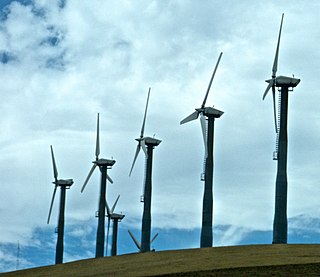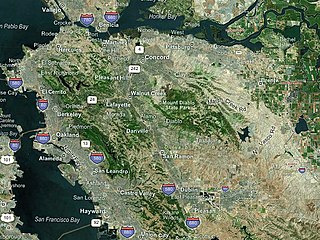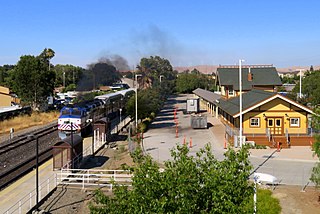
Livermore is a city in Alameda County, California. With a 2020 population of 87,955, Livermore is the most populous city in the Tri-Valley, giving its name to the Livermore Valley. It is located on the eastern edge of California's San Francisco Bay Area, making it the easternmost city in the area. The current mayor is John Marchand.

Tracy is the second most populated city in San Joaquin County, California, United States. The population was 93,000 at the 2020 census. Tracy is located inside a geographic triangle formed by Interstate 205 on the north side of the city, Interstate 5 to the east, and Interstate 580 to the southwest.

The Tri-Valley area is grouping of three valleys in the East Bay region of California's Bay Area. The three valleys are Amador Valley, San Ramon Valley, and Livermore Valley. The Tri-Valley encompasses the cities of Dublin, Livermore, Pleasanton and San Ramon, the town of Danville and the CDPs of Alamo, Blackhawk and Diablo. The area is known for its Mediterranean climate, wineries, and nature. It is primarily suburban in character. The United States Census Bureau defines an urban area centered in the cities of Livermore, Pleasanton, and Dublin with a 2020 population of 240,381, ranked 167th in the United States in terms of population. The total population of the area is estimated to be 361,000. It offers more affordable living accommodations than the cities of San Francisco and San Jose.

The Altamont Corridor Express is a commuter rail service in California, connecting Stockton and San Jose during peak hours only. ACE is named for the Altamont Pass, through which it runs. Service is managed by the San Joaquin Regional Rail Commission, and operations are contracted to Herzog Transit Services. The 86-mile (138 km) route includes ten stops, with travel time about 2 hours and 12 minutes end-to-end. In 2022, the line had a ridership of 389,100, or about 2,500 per weekday as of the third quarter of 2023. ACE uses Bombardier BiLevel Coaches, MPI F40PH-3C locomotives, and Siemens Charger locomotives.

Wheels is a public bus service in the Tri-Valley region (southeast Alameda County) of the San Francisco Bay Area in California, United States. It is operated by the Livermore Amador Valley Transit Authority (LAVTA). Wheels operates local and limited-stop service in Dublin, Pleasanton, and Livermore, with limited service into Contra Costa County along Interstate 680. The LAVTA was formed in 1985; service began in Dublin and Pleasanton in 1986. In 1987, it took over the 1978-opened Rideo service in Livermore. In 2022, the system had a ridership of 1,019,400, or about 4,500 per weekday as of the third quarter of 2023.

Altamont Pass, formerly Livermore Pass, is a low mountain pass in the Diablo Range of Northern California between Livermore in the Livermore Valley and Tracy in the San Joaquin Valley. The name is actually applied to two distinct but nearby crossings of the range. The lower of the two, at an elevation of 741 ft (226 m), carries two railroad rights-of-way (ROWs) and Altamont Pass Road, part of the old Lincoln Highway and the original alignment of US 50 before it was bypassed c. 1937. The bypass route travels over the higher summit, at 1,009 ft (308 m), and now carries Interstate 580, a major regional highway heavily congested by Central Valley suburbanization.

The East Bay is the eastern region of the San Francisco Bay Area and includes cities along the eastern shores of the San Francisco Bay and San Pablo Bay. The region has grown to include inland communities in Alameda and Contra Costa counties. With a population of roughly 2.5 million in 2010, it is the most populous subregion in the Bay Area.

The Iron Horse Regional Trail is a rail trail for pedestrians, horse riders and bicycles in the East Bay Area in California.

Dublin/Pleasanton station is a Bay Area Rapid Transit (BART) station on the border of Dublin and Pleasanton in California. It is the eastern terminus of the Blue Line. It is also a major bus terminal served by six providers.

The establishment of America's transcontinental rail lines securely linked California to the rest of the country, and the far-reaching transportation systems that grew out of them during the century that followed contributed to the state's social, political, and economic development. When California was admitted as a state to the United States in 1850, and for nearly two decades thereafter, it was in many ways isolated, an outpost on the Pacific, until the first transcontinental railroad was completed in 1869.

Santa Clara Transit Center is a railway station in downtown Santa Clara, California. It is served by Caltrain, Amtrak Capitol Corridor, and Altamont Corridor Express (ACE) trains. It is the planned terminus for the Silicon Valley BART extension into Santa Clara County. The former station building, constructed in 1863 by the San Francisco and San Jose Railroad, is used by the Edward Peterman Museum of Railroad History.

Pleasanton station is a train station in Pleasanton, California served by Altamont Corridor Express (ACE) trains. It is located northwest of downtown Pleasanton adjacent to the Alameda County Fairgrounds. The station has a single side platform on the single track of the Union Pacific Railroad Oakland Subdivision.

Livermore is a train station in downtown Livermore, California.
Throughout the history of Bay Area Rapid Transit, there have been plans to extend service to other areas.

eBART is a hybrid rail branch line of the Bay Area Rapid Transit (BART) system in eastern Contra Costa County, California, United States. The line extends the Yellow Line beyond Pittsburg/Bay Point station to Antioch station.

The Tracy Transit Center is a bus station in Tracy, California, United States. The facility serves as a bus hub for transportation on local, commuter, and long-distance bus services. It also replaced the Naglee Park and Ride Lot "as the place for people to meet buses and vanpools" when the Naglee lot was sold for development in spring 2017, "after the city’s negotiations with several shopping centers near Interstate 205 proved unsuccessful."
North Lathrop station is a planned Altamont Corridor Express station in Lathrop, California – the second to be constructed in the city. It was expected to open to revenue service in 2023 as part of the first phase of ACE's expansion to Merced, but was later delayed to 2027.
Southfront Road is a planned railway station in Livermore, California. It is a stop on the planned Valley Link system. Rush hour short turn Valley Link trains would operate from here to Dublin/Pleasanton. Service is expected to start as early as 2028.
Isabel station is a planned railway station in Livermore, California. It is expected to open in 2028 as a stop for Valley Link. The station's parking lot and bus bays are located on the north side of East Airway Boulevard while the platforms and rails are located in the median strip of Interstate 580 just east of Isabel Avenue.


















